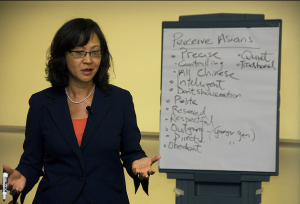I’ve spent a lot of time on this blog talking about academic subjects. I do that because I find them interesting and I have a strong background in those topics. However, I realize that not everyone who reads this blog will be academia-oriented, and this blog has the potential to answer some of their burning questions about language in the context of real-world applications and technology. For example: how does Siri work? How does voice recognition work? How can I use knowledge of language to help other people? How is language used in industry? Following my usual MO of starting with things I know the most about, I’ll tell you today about the field of accent reduction.
In college, I did an internship at the Accent Reduction Institute (ARI), under the direction of President and Founder Judy Ravin and CLO Barbara Niemann. Although the internship came highly recommended by a friend of mine because he loved the people he worked for, I was a little nervous about the job. As you can probably gauge from the topics of previous blog posts, I am very concerned with language discrimination and issues of social justice within linguistics. Was it okay to work for a company that taught people how to modify their foreign accents? Were we encouraging people to give up a part of their identity because being more American was the correct way to be?
In fact, I needn’t have worried. The views of the people at ARI were completely in line with my own. They use linguistic knowledge every day to help people in real, tangible ways. They were sensitive to issues of identity and did not denigrate the speech of their students. They also knew that many other people would see a strong accent as a reason to deny promotion to hardworking foreign nationals. In order to correct that problem, Judy Ravin developed the Ravin Method, taking her knowledge of phonetics and made it accessible to non-linguists. This allowed students to learn exactly how to move their tongue in order to master the trickier sounds of English.
This training has helped foreign nationals become more competitive in the workplace. White men completely dominate the executive positions in Fortune 500 companies. When many of ARI’s students completed their courses successfully, they were able to be promoted to higher-ranking positions. The majority of ARI’s students were diverse speakers of Spanish, Chinese, Hindi, and many other languages. These students were able to attend these courses because ARI was paid by the company they worked for, so the employees of the company were able to receive this valuable training without paying out of pocket.
Another impressive attribute of this particular company, which I believe is unique even in the accent reduction field, is that they provide services for native speakers of American English as well. While their main business was in helping foreign nationals learn American English pronunciation, they also helped people learn how to better understand speakers with foreign accents. They provided this training mainly to public employees, in the military and to firefighters and police officers. In an emergency situation, understanding the people you are helping is key. This program, called Building Bridges, puts the onus on Americans to learn how to deal with foreign accents, rather than requiring foreign speakers to seriously alter their pronunciation. At ARI, communication is a two-way street.
To read more about Accent Reduction, outside of my experience with ARI, you can read about it in this LA Times article by Anna Gorman.


